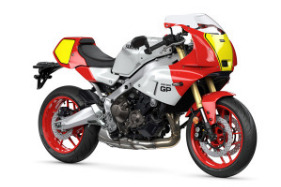
Born Iconic: The New XSR900 GP
The embodiment of Yamaha Racing history.
Blending nostalgic design with the latest technology.
The Sport Heritage range pays tribute to some of the most iconic motorcycles from Yamaha's rich history by blending nostalgic design with the very latest in high performance engine and chassis technology.
Each XSR model takes inspiration and design cues from some of the most significant bikes built by Yamaha in its 68-year history but sees no compromise in modern day performance by bonding this timeless beauty with cutting edge riding technology.
Racing is in Yamaha's DNA. Yamaha Motor Company has been competing in, and winning, motorcycle races since its inception – pushing the limits of both man and machine. Yamaha's first ever motorcycle, the YA-1, won the Mount Fuji Ascent Race in 1955 shortly after the company was founded.
Since then, Yamaha has amassed countless victories at all levels from local grassroots amateur racing to the premier class of Grand Prix.
First released in 2016, the XSR900 has long featured subtle hints to Yamaha's racing pedigree and in 2021, the latest generation XSR900 went one step further with clear design cues taken from race machines of the 1980s and 1990s while maintaining its position as a heritage roadster.
For 2024 the nod to Yamaha's racing tradition takes another leap with the introduction of the new XSR900 GP, which pays homage to some of the most celebrated race machines from Yamaha's illustrious past in a way never seen before in the Sports Heritage range.
Combining a sense of 1980s Grand Prix nostalgia with the very latest technology including the iconic, torque-rich 890cc CP3 engine, R1-derived six-axis IMU and lean sensitive rider aids, the XSR900 GP embodies Yamaha's Racing history without sacrificing modern day performance.
The 'Golden Era' of Grand Prix racing
Yamaha first entered a road racing world championship event at the Grand Prix of France in May 1961, and took its first GP victory in the 250cc class two years later. From there, the success flowed freely with Phil Read taking Yamaha to its first rider and constructor titles in 1964. To this day, Yamaha have now won over 500 Grand Prix races and are 39 times Grand Prix world champions.
The first premier class title came for Yamaha in the 1970s, with Giacomo Agostini, and further championship crowns followed later in the decade.
But it was in the 1980s that Yamaha secured its legacy in what would become known as the 'Golden Era' for Grand Prix racing. 'King' Kenny Roberts rode his YZR500 to a third consecutive title in 1980 but, following that success, Yamaha endured a tough few seasons battling for supremacy with its rivals.
This led to a re-think in approach, with a change in focus to developing race bikes with a priority on a rider's feeling with the machine.Not only would this new strategy lay the groundwork for further Grand Prix success (Yamaha won six 500cc Grand Prix titles between 1984 and 1992), but technology developed during this period went on to shape the future of the production sport motorcycle to this day.
Having moved to a slimmer V4 engine in 1982, Yamaha's engineers turned to developing a frame in which to house this powerplant. The idea was to produce a frame the same width of the V4 motor that would envelop it, like a cage.
This marked the birth of what would become the iconic Deltabox frame, which first featured in the 1982 YZR500 OW61 Grand Prix machine. Offering outstanding rigidity and feedback, just where a rider needed it most, the Deltabox posed such a significant step forward that just three years later Yamaha introduced it to a production model for the first time, with the TZR250 bringing the characteristics of the YZR factory race machine to the road.
And now, 40 years on, the Deltabox style frame remains at the heart of many Yamaha motorcycles, including the new XSR900 GP.
Born out of respect
The English proverb 'Manners Maketh Man' derives from a shared understanding that courtesy, good manners, and respect are essential to the preservation of good human interaction and relationships.
It is this concept which formed the starting point for the design of XSR900 GP, in harmony with the Faster Sons philosophy of respecting the origin, learning from the past and creating a better machine for the modern-day rider.
The aim was not to create a replica, but instead release a model that pays the utmost respect to the past, while holding its own with the latest in performance and technology. That is the XSR900 GP.
A sense of nostalgia in every detail
1980s inspired cowling
Aesthetically, Grand Prix bikes took a significant step in the 1980s, moving from the curvaceous bodywork of the 1970s towards the 'boxier' design seen from the mid-80s onwards. These squarer fairings would set the trend for the next decade not only at Grand Prix level but in production bikes too.
The XSR900 GP features an upper cowling reminiscent of this era, not only with a clear influence from the 1980s YZR Grand Prix bikes but also with notes of the FZR and TZR production sports machines of the late 1980s and early 1990s. To maintain the race-bike look, the XSR900's round LED headlamp is replaced by a compact lens module, neatly hidden in the front cowling, creating a sense of unity with the front fairing while maintaining excellent illumination.
The bodywork is not only a symbol of the past in looks alone, but the method in which it is fixed in position is also inspired by the 1980s, with a tubed structure connecting the cowling to the frame and straight brackets supporting the dash creating a rider's view with a genuine golden era feel.
To emphasise the classic cockpit feeling, the upper fairing stay is supported by a nut structure identical to that used for the original TZ250. In true racing style, this structure is fastened with a beta pin, marking the first time Yamaha has used such a fastening on a mass-produced production model for public road use.
The function behind the move from the curvaceous cowlings of the 1970s to the more squared off style of the 1980s was to both improve aerodynamic efficiency and protect the rider from the wind coming from higher performance; and this is no different with the XSR900 GP.
While the windscreen and individual knuckle guards incorporate a taste of the 1980s; it's not solely about looks. The power output and gear ratio of the 890cc CP3 engine are identical to that of the XSR900, but the front cowling structure of the XSR900 GP increases both acceleration and top speed while the ducts on the side panels efficiently discharge heart from the radiator to maximise cooling performance.
The colour-matched seat cover fits over the passenger seat to complete the racer look with a boxy 1980s style rear end hiding the rear light, while a seat stopper on top of the seat cowling keeps the rider in position to enhance the feeling of acceleration.
Colours reminiscent of the Rainey years
Adorned in one of the most iconic Yamaha Grand Prix colours of all time, the XSR900 GP is available in a heritage livery inspired by the machines ridden by riders such as Wayne Rainey to multiple 500cc Grand Prix World Championships in the 1980s and early 1990s, complete with authentic yellow number boards on both front and rear cowlings.
The Deltabox-style chassis and swing arm are finished in silver to better evoke the era of the 1980s prototypes and emphasise the character of the Deltabox style frame itself.
A sportier ride
Race-style clip on handlebars
Separate 'clip on' handlebars add to the racer-style cockpit and offer a sportier riding experience. The revised handlebars drastically change the riding position from the XSR900, moving the rider further forward on the machine into a sportier riding position, increasing the load on the front to offer the more precise feeling expected from a race-style machine.
However, since the model is not purely focused on racing or circuit riding, care has been taken to ensure the riding position does not lean forward excessively, instead offering a balance which can be enjoyed on the road without discomfort. The comfort is emphasized via a thicker, more supportive seat.
The aluminium diecast footrests are adjustable to two different positions but come out of the factory set at the upper position to emphasise the sportier riding position.
Tuned rigidity
To accommodate the extra load on the front end of the machine, as a result of the more forward riding position, the XSR900 GP areas surrounding the frame have been tuned to optimise stability in turning. The subframe has also been reinforced over the one found on the XSR900.
To further correspond with this front end-led riding style, the XSR900 is the only CP3 model to feature an aluminium steering stem shaft, adjusting rigidity in the steering area to better balance the often conflicting feelings of lightness and stability when changing direction or under rapid deceleration.
In conjunction with the lightweight Spinforged wheels and new Bridgestone Battlax Hypersport S23 tyres the rider can have precise confidence in placing the XSR900 GP exactly where they wish.
Cutting edge technology
High performance brakes and suspension
In line with the mantra of blending yesterday's style with modern technology, the XSR900 GP boasts the latest in suspension and braking components.
The KYB upside down front forks are fully adjustable for Preload and compression damping as well as rebound damping, so the ideal setup can be found for front end feel. The link-type rear suspension actuates a forward-inclined fully adjustable KYB shock virtually hidden from sight to maintain the slim and sporty performance at the rear.
Remote pre-load adjustment makes customising the ride a simple task.
A Brembo radial front master cylinder underlines the bike's cutting-edge specification and backs up its sporty potential, while the brake hoses have been optimised to improve braking control in sportier riding, especially under harder stopping forces.
Yamaha Ride Control (YRC)
Further maintaining the mix of nostalgic style with the latest in high performance technology, XSR900 GP riders can customise their riding experience via Yamaha Ride Control (YRC). For simpler use, engine power characteristics and rider aids are integrated to quickly allow changes to the level of electronic intervention depending on rider preferences and road conditions.
Three pre-set integrated riding modes, 'SPORT', 'STREET' and 'RAIN' feature factory settings with different intervention levels to suit different conditions. These are complemented by two Custom settings, which enable the rider to manually select their own power and intervention settings for the various electronically controlled, lean-sensitive rider aids – all of which can be set using a smartphone via the MyRide app.
5” TFT meter with full connectivity
A new five-inch full colour TFT display is housed in the retro-styled cockpit. While riders can choose from four different themes to suit a range of mindsets, a traditional analogue-style tachometer theme, inspired by race bikes of yesteryear truly enhances the period riding experience.
For an enriched riding experience, smart phone connectivity comes as standard on the XSR900 GP via a built-in Communication Control Unit (CCU), ensuring riders can stay connected while riding by linking their smart phone with their machine via the free MyRide Link app. As well as seeing call and message notifications on the 5” TFT display, a new dimension is added to the ride by the possibility of taking calls and listening to music via a Bluetooth headset*.
Once connected, riders can also make use of the integrated Garmin StreetCross navigation system which will display Turn-By-Turn navigation on the 5” TFT dashboard.
There is also the option to provide power to external devices by the new USB Type C socket located near the dashboard.
*Bluetooth headset not included with bike
New ergonomic switchgear
New integrated handlebar switch assemblies enable the rider to operate the wider range of functions of the new XSR900 GP including smart phone connectivity, navigation and riding modes as well as interrogating the various menu options.
Featuring a clear, logical and simple design – the shape, movement and ergonomic layout of the buttons have been designed with intuitive movement in mind, meaning riders can cycle through the different functions with ease.
To aid navigation of busy road environments, a soft-click of the indicator switch will flash the turn signals three times for use when lane-changing or when only brief indication is required. A full-click of the switch will result in continuous flashing until 15 seconds has passed and when the machine has travelled more than 150 metres.
A new Emergency Stop Signal (ESS) function reacts to sudden braking by engaging the hazard lights to warn road users behind the vehicle is stopping at speed in an emergency situation.
Extra support from advanced six-axis IMU with lean sensitive rider aids
Developed directly from the electronic systems on the R1, the XSR900 GP's high-tech six-axis IMU constantly measures acceleration in the forward-backward, up-down and left-right directions – as well as the angular velocity in the machine's pitch, roll and yaw directions.
The six-axis IMU is able to send data in real time to the ECU which controls the suite of electronic rider aids, including the lean sensitive Traction Control System (TCS), Slide Control System (SCS) as well as a front wheel Lift Control System (LIF) and Brake Control System (BC).
XSR900 GP also becomes the first Sport Heritage model to be equipped with the third-generation quick shift system, enhancing the ride by enabling clutchless downshifts while accelerating and clutchless upshifts under deceleration in addition to the standard functionality.
Technical Highlights
- Distinctive design evocative of Grand Prix racers of 80s and 90s
- New 5-inch full colour TFT display with connectivity
- High grade fully adjustable front and rear KYB suspension
- Newly designed clip-on handlebars and handlebar switches
- Deltabox-style chassis with optimised rigidity
- Comfortable main seat, new side covers and removable seat cover
- New footpeg style and positioning
- Yamaha Ride Control YRC and 6-axis IMU
- Cruise control, third generation Quick Shift System and A&S Clutch
- EU5+ compliant sophisticated high-torque CP3 890cc engine
- Yamaha Spinforged wheels fitted with Bridgestone Battlax Hypersport S23
Colours
The new XSR900 GP will be available in two colours Legend Red and Power Grey.






